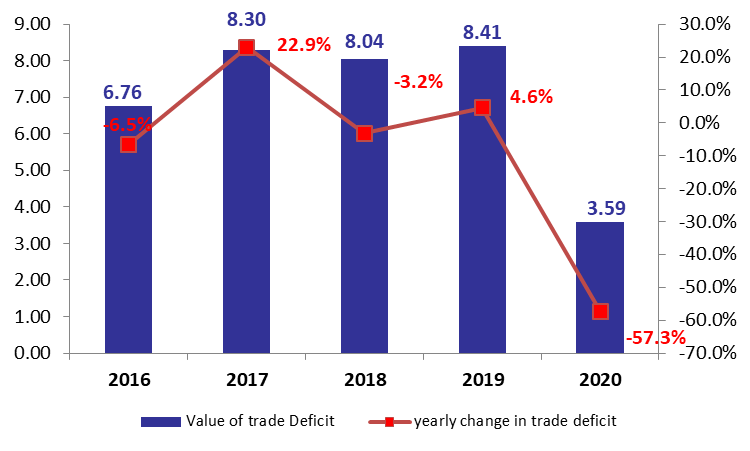In the first half of 2020, Lebanon’s trade deficit totaled $3.59B, narrowing from the $8.41B registered in the same period last year. In fact, total imported goods retreated by 48.7% year-on-year (YOY) to $5.20B by June 2020. Meanwhile, Lebanon’s total exports declined 6.8% YOY to $1.61B by June 2020. In fact, trade activity was affected this year by the coronavirus outbreak as businesses in the transportation, production and storage industries were shut down. In addition the Lebanese trade activity has further deteriorated by the current economic and financial crisis. In details, the country is witnessing a national foreign currency shortage and multiple exchange rates which are directly affecting the import activity.
In term of value, the “Mineral products” grasped the lion’s share of total imported goods with a stake of 28.53%. “Products of the chemical or allied industries” ranked second, composing 15.43% of the total while “Vegetable Products” and “Prepared foodstuffs; beverages, tobbaco” grasped the respective shares of 8.21% and 7.79%, respectively.
In details, Lebanon imported $1.48B worth of “Mineral Products”, compared to a value of $3.37B in the same period last year. In fact, the net weight of imported “mineral fuels, oils and their products” decreased since last year and witnessed a yearly drop from 6,008,754 tons in H1 2019 to reach 3,331,666 tons in H1 2020.
In turn, the values of “Products of the chemical or allied industries”, “Vegetable Products” and “Prepared foodstuffs; beverages, tobbaco “recorded yearly drops of 22%, 23.41% and 36.45% to settle at $802.94M , $427.37M and $405.10M, respectively.
By June, the top three import sources were Greece, Italy and US grasping the respective shares of 7.87%, 6.99% and 6.95% of the total value of imports.
On the Exports front, Lebanon’s top exported products were “Pearls, precious stones and metals” grasping a share of 39.27% of the total. “Prepared foodstuffs, beverages & tobacco” and “Machinery, electrical instruments” followed, with each grasping a share of 11.52% and 9.77%, respectively, of the total.
In detail, the value of “Pearls, precious stones and metals” climbed yearly by 11.29% to $633.16M by June 2020. Meanwhile, the value of “Prepared foodstuffs, beverages & tobacco” and “Machinery, electrical instruments”, witnessed a yearly declines of 7.18% and 15.23% to reach $185.78M and $157.59M, respectively in H1 2020.
The top three export destinations by June 2020 were Switzerland, UAE and KSA with the respective shares of 31.98%, 10.59% and 6%.
Worth mentioning that the volume of imported goods is expected to decrease further in the upcoming months if the central bank decides to stop covering the import of essential goods at the official exchange rate. In this context, S&P rating agency forecasts the current account deficit to decline to 4% of GDP in 2020, from above 20% in 2019.
Trade Deficit in H1 ($B)
 Source: Lebanese Customs, BlomInvest Bank
Source: Lebanese Customs, BlomInvest Bank